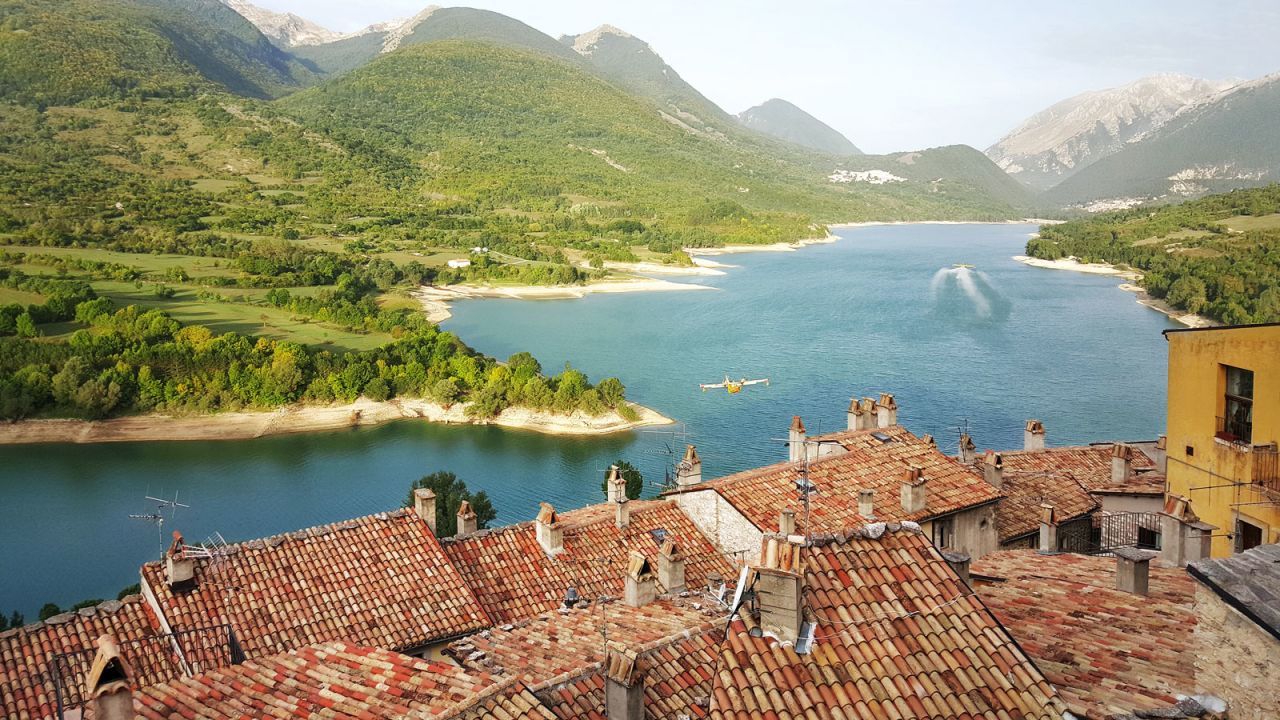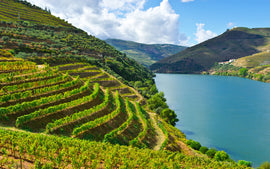ABRUZZO
We spent last month in Trentino- Alto Adige, adjusting to the altitude and confusing appellations. So April seems like a good time to continue our climb in the likewise alpine Abruzzo, about 700 kilometers to the south. Abruzzo is only a few hours east of Rome but, squeezed between the Apennine Mountains to the west and a long Adriatic coastline to the east. It bouquets three national parks, 38 nature reserves, and an amazing 75% of the flora and fauna on the continent into a whole ‘nother green world. A third of its 4,900 square miles consists of officially protected land, and two thirds are covered by rugged peaks, which provide great (if labor intensive) conditions for viticulture: thin soils, big diurnal temperature shifts, and cool mountain air currents, moderate the temperatures in the vineyards on the slopes, providing a perfect microclimate for the vines. Closer to the coast, the climate becomes wetter and more temperate, receiving a decent amount of annual rainfall.
So it’s no surprise that Abruzzo goes way back with wine. Officially, the local tradition starts with the Etruscans in the 6th century B.C.E., but there is evidence that vine growing began in the 4th century B.C.E., when a sweet, Moscato-style grape called Apianae was grown. It is also believed that when Hannibal made his epic journey over the Alps, his soldiers were given Abruzzo wine from Teramo (historically known as Pretuzi). Whatever the case, today Abruzzo ranks fifth amongst Italy’s 20 regions in terms of wine production per annum. More than half of it’s output consists of the red grape Montepulciano, the fifth most planted grape in Italy, forever fated to be confused with Vino Nobile di Montepulciano, a famous wine from the Tuscan medieval town Montepulciano that is mainly produced with a local Sangiovese clone known as Prugnolo Gentile. In fact, the grape Montepulciano is not grown in the town of Montepulciano at all, despite being widely planted all over Central Italy – in Marche and Emilia Romagna, for instance - and having more than 50 DOCs dedicated to it. One of the most famous is Montepulciano d’Abruzzo, which is mostly known for producing soft, approachable and affordable reds, more fruit forward than Sangiovese, valued for their deep color, moderate acidity, mellow tannins, and intense flavors. Our red this month is a more robust and complex take on Montepulciano D’Abruzzo, grown in the very specific mountainous terroir of the village of Ofena, in the L’Aquila province, 500 meters above sea level.
Our white is made from the Pecorino grape, which is thought to have originated in Marche. The name comes from the fact that shepherds moved herds of sheep across the region who munched on the grapes, which were called Uva delle Pecore or Uva Pecorina (sheep’s grape). By 1980, the varietal was almost extinct, disfavored by vintners because of its low yields and unpredictable final product. But like Pinot Noir, Pecorino is extremely terroir sensitive and reflective, and in the hands of patient, dedicated winemakers, it can make for incredibly structured, remarkably layered wine that outperforms its price point. Abruzzo in particular has an almost mystical relationship to the grape, its higher rocky slopes and lower coastal influence producing some of the most complimentary growing conditions for its finicky nature. Ciavolich is a long-established winery in the Pescara province, located on a hilltop overlooking the Adriatic Sea, and its Pecorino is a great ambassador for the depth of this grape and region symbiosis.
Salute!
Alan Hicks - PlumpJack Noe Wine Buyer
|
Ciavolich Aries Pecorino 2021 |
|
|
Region: Abruzzo, Italy |
About the Winery: The Ciavolich family traces their roots back to Bulgaria in the 1500s. A family of wool merchants by trade, they eventually left their homeland to escape the Saracen invasion. They settled in Miglianico in the province of Chieti around the year 1560. In 1853, they built their first wine cellar which still stands today as one of the ancient winemaking landmarks of the Abruzzo region. The cellar was built underground beneath Via Sud and connects to the barrel rooms under the palace. A wide cave on the Eastern wall of the winery was expanded during the Nazi occupation and reached under the convent of Suore di Sant'Anna. This tunnel was used during WWII as a bomb shelter until the family was finally forced from the estate in December 1943. At the end of the war, the family returned to Miglianico. Life and winemaking eventually began again. In the 1960s the family inherited from Donna Ernestina the Loreto Aprutino estate in the province of Pescara. Since 2004, the estate has been run by Chiara Ciavolich and her husband Gianluca. They have brought a modern approach with traditional philosophy to the viticulture and winemaking. Sustainable methods are employed both in the vineyards and throughout the entire winemaking process. About the Winemaking: The grapes come from one hectare of pergola abruzzese planted in 2000 on the Ciavolich estate of Pianella and from one hectare of cordon-double guyot in Loreto Aprutino planted in 2011. The grapes are hand picked in the first daylight and carried directly to the winery in small baskets. They are pressed softly and the must ferments under controlled temperature in stainless steel vats. When fermentation ends a small part of it is moved in 2009 French oak tonneaux for a short elevation of three months. At the end of February the wines are reassembled and bottled to continue aging for about two months. Tasting Notes: Herbal scents such as rosemary, thyme, sage and peppermint go along with hints of yellow pulp fruit. A high acidity with a sapid and mineral ending enhances the taste. |
|
Winemaker: Chiara and Gianluca Ciavolich |
|
|
Price per bottle / per case $24/$259.20 |
|
|
Suggested Food Pairing: gnocchi with asparagus, bacon and crispy bread crumbs, chitarrina with broad beans, beans and Farindola Pecorino cheese, seafood risotto with bottarga, bruschetta with liver and onion, fettuccine with porcini mushrooms. |
|
|
Inalto Montepulciano D’Abruzzo 2018 |
|
|
Region: Abruzzo, Italy |
About the Winery: Adolfo De Cecco is part of a new generation of wine entrepreneurs that has come to the stage in recent years. The son of Francesco Adolfo De Cecco, who helms the renowned De Cecco pasta makers’ dynasty, Adolfo's vision is to make wine from a specific cru with the intention to achieve the best expression of a particular grape from that particular site. He pitched the concept to Thomas Duroux, winemaker and general manager of Chateau Palmer, the famous Margaux Third Growth vineyard in Bordeaux and after touring the entire Abruzzo region, De Cecco and Duroux selected Ofena, in the province of Aquila, an area almost 500 meters above sea level. This,they decided, was the perfect location to produce refined and elegant wine. The area is known as Forno d’Abruzzo, Abruzzo's oven, because despite the high altitude, the terrain is shaped like a bowl and retains the heat from the sun, which helps to ripen the grapes uniformly. The cool nights preserve the fragrance and elegance of the fruit. About the Winemaking: The vines are between 30 and 50 years old, presently under conversion to organic protocols. The harvest was at the end of October, the bunches were sorted, de-stemmed and then crushed. Fermentation is in temperature-controlled (28°C) steel tanks, the wine remains on the skins for 26 days with regular pumping over. The wine is then moved into tonneaux (3rd use, 500 liter French oak) where it goes through malolactic conversion and matures for 14 months before the final assemblage and bottling without filtration. Tasting Notes: Nose scented with soft notes of oak, ripe red and black plums and bramble fruits with notes of hot stones baked in the sun. On the palate it is richer with juicy plums and brambles and an iron mineral note, stony and salty on the finish. The tannins are soft around the edges but with a sticky mineral center, almost like a soft, chewy toffee with a plum flavor, and slightly spicy. Rich, ripe and tasty. |
|
Winemaker: Thomas Duroux |
|
|
Price per bottle / per case $37/$399.60 |
|
|
Suggested Food Pairing: Bucatini alla Amatriciana, pappardelle with wild boar ragù, arrosticini, barbecue, shepherd's pie, stuffed baked potato, aged cheddar, roasted mushrooms.
|
|
Fettuccine al forno con salsa di pomodoro, erbe aromatiche e scamorza
(Baked fettuccine with tomatoes, aromatic herbs and smoked mozzarella)
Ingredients (serves 4-6)
3 tbsp. extra virgin olive oil
2 cloves garlic, finely chopped
4 leaves fresh mint, finely chopped
8 fresh basil leaves, finely shredded
2 tbsp. fresh parsley, chopped
1-15 oz can tomatoes, chopped
1⁄2 peperoncino or 1⁄4 chili flakes
1⁄4 cup freshly grated Pecorino cheese
1⁄4 lb. scamorza (or mozzarella)
1 lb. fettuccine
Instructions
1 .In a large skillet, heat the olive oil over medium flame.
- Sauté the garlic until golden
- 3. Add basil, parsley and pepperoncini and sauté for a minute or two.
- Stir in the tomatoes, salt and pepper
- Cook over medium-high heat stirring until the sauce thickens, about 15 min.
- Meanwhile, bring a pot of water to boil
- Cook the pasta al dente. Don’t overcook!
- Preheat the oven (while the pasta cooks) to 425 F
- When the pasta is ready, transfer to a baking dish.
- Mix with sauce, sprinkle the pecorino and lay the slices of scamorza* or mozzarella on top.
- Bake for a few minutes till the cheese melts and get a nice golden color
- Serve hot
*smoked mozzarella




